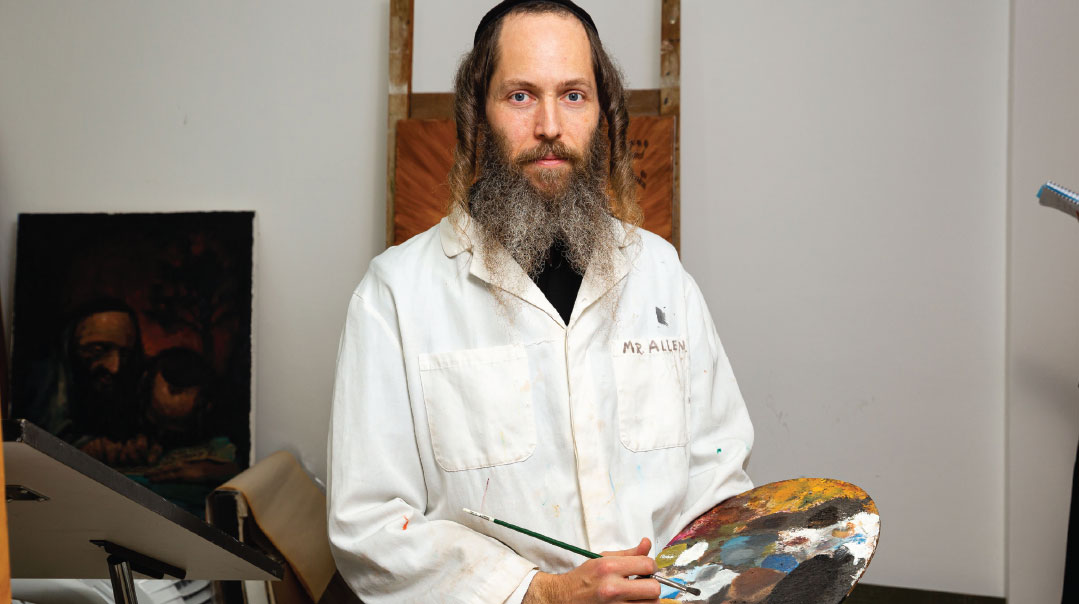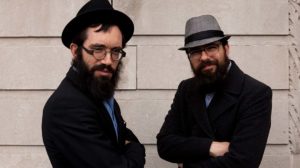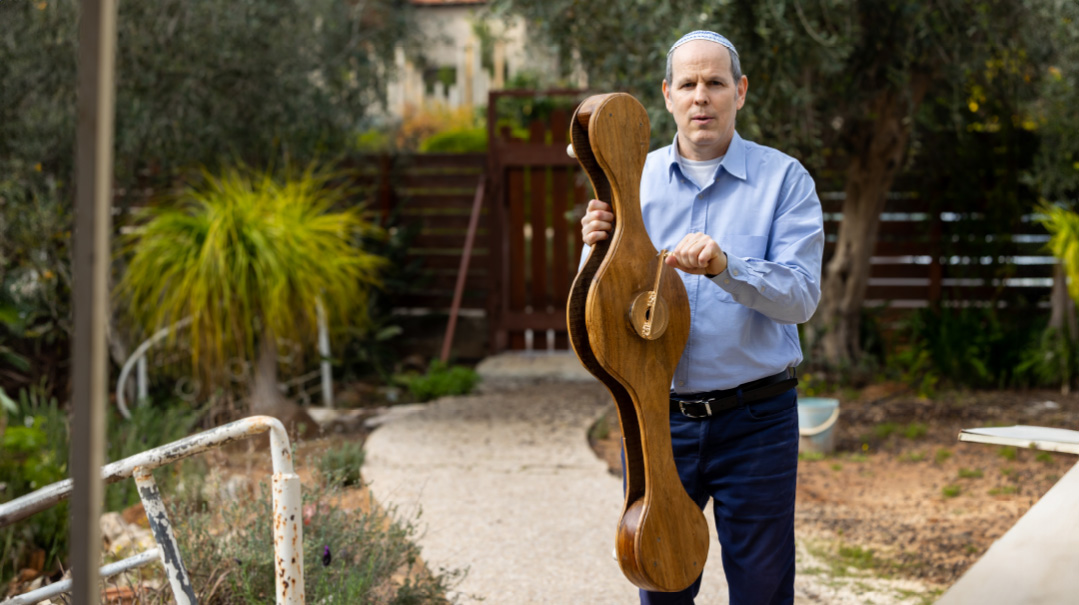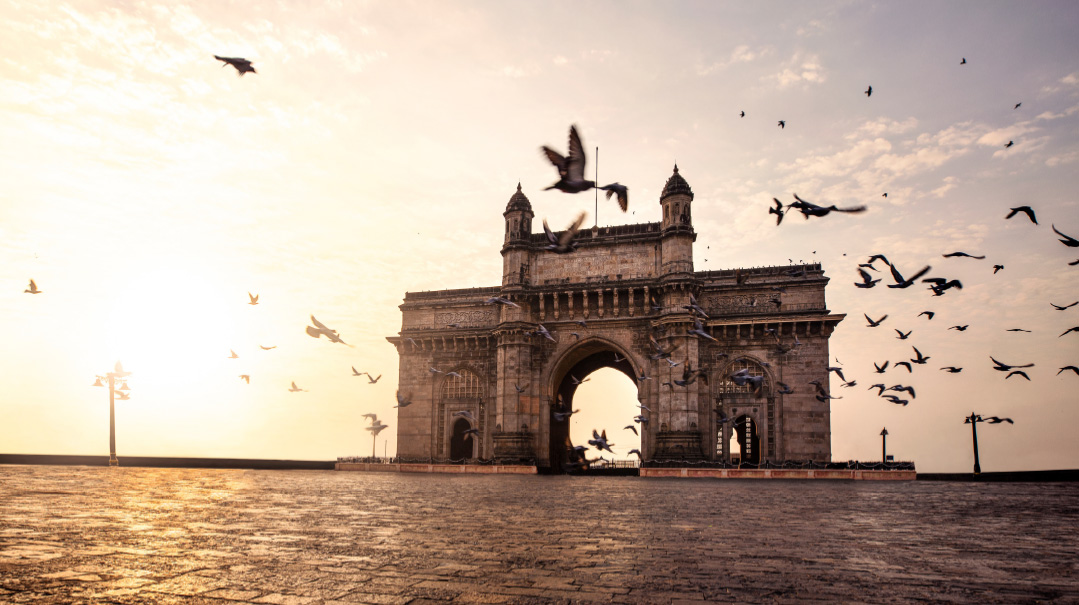The Whole Pictures

They say art imitates life, and artist Binyomin Allen can attest to this in at least one respect: Perfect results mean staying true to the original

We’ve all seen pictures of Rav Yosef Shalom Elyashiv ztz”l. But consider the hand-drawn portrait of the gadol produced by Beitar Illit artist Binyomin Allen.
The fingers perched on the furrowed brow. The deep-set eyes, focused like lasers. The white wisps of beard and peyos. The rumples in the black felt yarmulke.
Although any of the many photographs of Rav Elyashiv can be said to preserve a true image of him — does the camera lie? — somehow Binyomin Allen’s eye sees more.
“A lot of times people say ‘you’ve captured their spirit,’ ” says Allen, 40. “There’s a synergy, I guess you could say, something that results in a total greater than the sum of its parts. An artist has to pay attention to klal and prat.”
Hands Down
Allen moved to Beitar from Monsey six years ago and got married eight months later. He had been learning at Ohr Somayach, davening in the Skver shtetl, and casting about for a means of earning a steady livelihood. His talents clearly lay in art, but he was struggling to make it pay.
“I was mamash ready to throw in the towel on this thing,” Binyomin recalls.
And then a friend from Passaic called Binyomin’s father to propose a business partnership. This friend (we’ll call him “Leib,” as he prefers to remain anonymous) had known Binyomin from their time together at Ohr Somayach and was well aware of the young man’s talents.
“He was a classic starving artist, sitting in a shul lobby drawing people’s portraits for $5,” Leib recalls.
Leib commissioned Binyomin to draw a portrait of Yad Ezrah founder Rav Asher Freund ztz”l, for a friend. One idea led to another, and Leib and Binyomin soon inked a deal to produce hand-drawn portraits of gedolei Yisrael, to be sold over a website called simply Gedolim Portraits. Leib would run the website and handle all the orders and new commissions. Binyomin in turn produced 114 portraits over the course of three years and still receives inquiries for new commissions from visitors to the website.
“He had the chush in business, and I had the chush in art, so it was a good shidduch,” says Binyomin of his partnership with Leib.
Binyomin was able to pay the rent with the earnings from his portraits and eventually to make the move to Eretz Yisrael and assume the role of a chassidish yungerman, helping support his household. Since then he has been able to capitalize on his prior experience in graphic design, manuscript illumination, digital animation, and also embark on an entirely new direction: safrus.
“The umanus side of safrus is the hardest part for most people taking it up, but for me it was actually the easier part,” Binyomin says. “For me the challenge has been in learning the vast body of halachah associated with it, but I had a little bit of an advantage with the technical skill — the ‘chush in der hant,’ as they say.
“It’s much more of a steady parnassah, for sure, and it’s also klei kodesh — which means whether or not I’m getting paid down here, I’m still earning sechar.”
Suited for Sketching
Binyomin is the third of seven children in a multitalented family. His father, Mordechai Yaakov, is himself an artist of many years’ standing. His siblings are also engaged in a variety of creative pursuits, ranging from writing and illustrating to clothing design and developing recipes.
The family moved around a lot as Binyomin was growing up, from Iowa to Syracuse, New York, then to Florida, and then Passaic, New Jersey. His siblings, most of whom are now also married, have settled in disparate locations around the globe: Bloomingburg, New York, Golders Green, and New Jersey, to name a few. His parents joined him in Eretz Yisrael a couple of years ago and now live around the corner.
The creative roots run deep with the Allens. Family lore has it that Mordechai Yaakov’s mother passed by a shop window and spied a smart women’s suit that caught her fancy. She whipped out a pen and sketched it on the back of an envelope, then designed and assembled the suit on her own.
That native talent was passed to the next generation. Mordechai Yaakov received formal training, earning a bachelor’s degree in art at the University of Iowa, and went on to a productive career in various facets of art — teaching it in schools and colleges as well as heading up the graphics department of a telecom company in Syracuse. Where he was able, he gave as many tips to Binyomin as he could. He received the ultimate nachas for an artist when his son’s ability surpassed his own.
“His eye and control of the medium is way beyond my level,” says the proud father.
The instruction Binyomin received from his father turned out to be the closest thing he would receive to formal training. He considered enrolling in an art school when he was 15 and the family was living in Florida, but his skills had advanced to the point where his work was being displayed in local galleries.
“He had a decent following in Florida,” Mordechai Yaakov says. “But it’s hard to make a living with this until you’ve made a name for yourself in the art world.”
After the family moved to Passaic, Binyomin branched out to take frum clients. He began producing work for Torah Umesorah to be distributed through their website to Jewish schools nationwide. (His illustrations can still be found on the site.)
“I got a crash course in art education for frum schools,” he says with a chuckle. “In the pictures for Pesach, for example, I had to be very precise. Certain chassidim hold the becher this way, Sephardim dress differently at the Seder than Ashkenazim do. I had to portray ‘V’higadeta l’vincha’ in three different ways.”
Mirror of the Soul
Binyomin’s work these days commands a higher price. He says he got to this level by sticking to a well-refined protocol about art. For one thing, he almost always works from photographs. Although he values sketching from real life, he points out that photographs don’t tire the way models do. But the reasons go deeper than that.
“I’ve always preferred to work from photographs and not engage in the expressionistic style of art, which is mostly just painting from imagination,” he explains. “It’s better to see a reality and try to meet the reality. It’s a lot like Yiddishkeit — we try to stay close to our mekoros.”
When Binyomin begins building a piece, he sets out on a painstaking process. It usually starts when he receives a picture from a client: He assesses it for any particularly challenging elements — for example, the weave in a child’s straw hat or the floral design on a rebbe’s beketshe. After that, he narrows the frame of reference down from the photograph, perhaps manually mapping the image to a grid, depending on its complexity. Then he begins drawing the piece, penciling a very light schematic to outline the proportions before adding any details. For him, this process serves as a mashal for life.
“First, make sure you have perspective on the big picture, then start going in b’iyun,” he says. The first stage of adding details, Binyomin says, is carried out “in the most reasonably thorough way I can” — not getting into the very finest points yet, but putting in the main values for light and shadow. He goes over it again, this time adding a bit more. If he’s working on a painting, here he applies the main colors. After that, he fleshes out the main focal points of the picture. When, finally, all the details have been filled in, he comes to a stage he calls “fine-tuning.”
“I hold both the original photograph and my picture next to each other, up to a mirror,” he says. “When you see things in reverse, you see a lot of mistakes — things that are not balanced or proportioned correctly. If I darkened the area underneath an eye too much, I’ll see in the mirror that he looks like he has a black eye. This is really how I see what the picture is going to look like to the client.
“I always have to probe a picture until I finally get everything, or as much as I can, and then I send it off. If they see the original person, then I know I succeeded. I only know the photo I received, I know nothing else. They knew the person.”
Binyomin relates that he was once commissioned to draw a portrait of a beloved family patriarch, recently niftar, by the children and grandchildren. All they gave Binyomin was a photo. When the finished portrait was presented to the almanah, she said, “I don’t know who did this drawing, but whoever it was, he knew Moshe.”
“That was a big compliment for me,” Binyomin says. “When they say that, you know you did it right.”
Hang in the Balance
Working in this field has taught Binyomin the crucial importance of every detail and value. The smallest change can make a big difference.
“I learned a very important rule from my father — you always draw what you see, not what you know is there,” he says. “Sometimes it comes out so perfect, it’s exactly like what was in the photograph. But the fundamental principle is that you have to draw only what you see, not what your mind knows is there. Because most people, when they think of an eye, they think of eyelashes, irises — so they draw each of those parts individually. And then it doesn’t always look so much like the real thing.”
If there is a key to producing a portrait that captures the spark of life, Binyomin says, it lies in carefully maintaining the balance between the klal and the prat, perceiving both the forest and the trees.
“I’ve spent days where I got comfortable in front of my easel, and I paint with my nose two inches away from the canvas,” he says. “At the end of the day I step back and look, and I say, ‘That’s terrible!’
“Art is a mashal for reality. To focus on one side only makes a problem for the other side. Sometimes I’ll see a picture in a gallery window, it just hits me from across the street. And then I go up close and look at it, and I think, Okay, it’s nice, but it kind of fell apart. Once you see the details, it doesn’t hold the same appeal.”
Binyomin says the process he has developed for himself is a big facilitator in striking the right balance. “As long as I’m sticking to the principles of the process, the end result will, I hope, be what it’s supposed to be.”
Nevertheless, even though he follows a well-defined process, he doesn’t sugarcoat the arduous labor involved in producing a work of art.
“You have to be out of your comfort zone,” he says. “I’ve worked on paintings where I really had to push myself, almost to the point of being sick. It’s a tension, almost more than writing with safrus. In safrus, you have to be 100 percent focused, constantly. But there’s a system, there’s a rhythm, you have halachos, gedarim, it’s black and white — literally.
“With painting, or with drawing, you also have to maintain that tension all the way to the last minute — albeit in a different sense. But then when you get to the last minute — sometimes, it’s even the last hour of a painting that’s been going for months — it can make the whole difference between a mediocre work and one that just bounces off the canvas. You sit down, you lean forward, you lean back, you stand up, sometimes you stand upside down. You look at it in the mirror. All sorts of techniques. You have to look at it from every angle. There’s no real relaxation.”
And with the need to maintain that constant tension, even up to the last minute, how does he even know he’s reached the last minute? How does he know when a work is done?
“That’s the hardest part,” he concedes. “That’s the part that’s always nerve-racking, because one step too far, and you’ve ruined the whole work. Many times I’ve worked on a drawing, worked over and over it, and eventually it just ends up with a lack of chiyus because I put in too many details without focusing on the klal.
“Once I was drawing a portrait of a rebbe, and I got very involved in putting all the details into his beketshe,” he says. “When I stepped back, I realized it drew attention away from the main focal point — his face. You have to prioritize. What is going to enhance the whole? What will detract? What details do you need to summarize? Because it’s a very fine balance, knowing which details to take and which ones to leave. It’s a whole chochmah within the chochmah.”
Connect the Dots
Binyomin’s business partner, Leib, explains that the logic behind the gedolim series was to bring the decor in frum homes to a new, elevated level.
“Everyone loves to hang pictures of gedolim on their walls,” Leib says. “But a lot of times it ends up looking a bit eclectic — different sizes, different colors, different mediums. Now we’re able to provide a collection of portraits of uniform quality and style.”
Clearly, however, for Leib this is not the main selling point. He is in awe of Binyomin’s process and unabashedly extols its fruits.
“If you take the drawing and put it next to the original picture, every single hair, every single wrinkle, you go through the entire beard, the peyos — there’s not one hair that’s different,” he marvels. “Look at his portrait of the Bobover Rebbe. Look at the peyos. It’s phenomenal what Binyomin was doing — he was really connecting.”
(Originally Featured in Mishpacha, Issue 801)
Oops! We could not locate your form.












